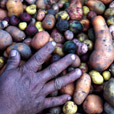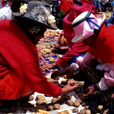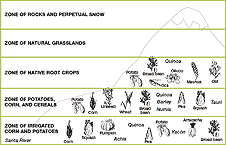Introduction
Biodiversity
 The Cornell-Peru Project is an example of the development paradigm of the 1950's and 60's that became known as the Green Revolution. One of the unexpected consequences of the program was a negative effect on the biodiversity of the region because the project promoted mono-cropping of "improved" varieties of potatoes for the commercial
The Cornell-Peru Project is an example of the development paradigm of the 1950's and 60's that became known as the Green Revolution. One of the unexpected consequences of the program was a negative effect on the biodiversity of the region because the project promoted mono-cropping of "improved" varieties of potatoes for the commercial
 market in Lima with the use of chemical fertilizers and pesticides (Lynch, 1982). This module describes the history of the decline in biodiversity as a consequence of external development efforts and how, nevertheless, biodiversity was preserved by some members of the community. Women, who had been excluded from Cornell's efforts to commercialize agriculture, played a key role in preserving biodiversity by continuing traditonal practices. Currently a group of peasants called "Nurturers" work with the NGO, Urpichallay, on the conservation of agro-biodiversity utilizing selected agricultural practices. In 2005 Vicosinos cultivated more than 100 varieties of potatoes, as well as other root crops such as 49 varieties of oca, 12 varieties of mashua, and 19 varieties of olluco. Moreover, 26 varieties of corn, 6 varieties of quinoa, and 30 varieties of beans were grown.
market in Lima with the use of chemical fertilizers and pesticides (Lynch, 1982). This module describes the history of the decline in biodiversity as a consequence of external development efforts and how, nevertheless, biodiversity was preserved by some members of the community. Women, who had been excluded from Cornell's efforts to commercialize agriculture, played a key role in preserving biodiversity by continuing traditonal practices. Currently a group of peasants called "Nurturers" work with the NGO, Urpichallay, on the conservation of agro-biodiversity utilizing selected agricultural practices. In 2005 Vicosinos cultivated more than 100 varieties of potatoes, as well as other root crops such as 49 varieties of oca, 12 varieties of mashua, and 19 varieties of olluco. Moreover, 26 varieties of corn, 6 varieties of quinoa, and 30 varieties of beans were grown.

Credit: Urpichallay Association
Read More about Biodiversity
